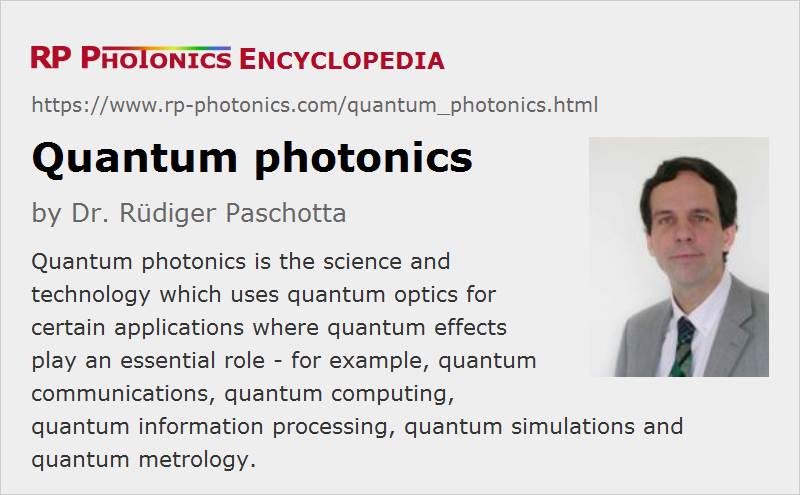Quantum Photonics
Definition: the science and technology using quantum optics for applications like quantum communications, quantum computing and quantum metrology
More general term: photonics
German: Quantenphotonik
Categories: photonic devices, quantum optics
How to cite the article; suggest additional literature
Author: Dr. Rüdiger Paschotta
Quantum photonics is the science and technology which uses quantum optics for certain applications where quantum effects play an essential role:
- In quantum communications, one exploits e.g. the non-cloning theorem for safely preventing undetected eavesdropping. See also the articles on quantum cryptography and quantum key distribution.
- In quantum computing, one encodes information with quantum bits, in short qbits, as linear superpositions between two states of a photon or an atom, for example. (In contrast, a classical bit can always be only in one of the two states, not in a superposition.) If a combination of N qbits is used, that can be in a superposition of 2N states. The coherent evolution of such qbits under well controlled conditions depends on all involved quantum states and can thus be used to perform certain operations with far higher speed than is possible with classical computers. For example, it should be possible to perform certain operations which allow one to crack current cryptography systems which would appear to be completely safe against the use of conventional (classical) technologies. Both analog and digital realizations are considered and developed; for example, there are quantum logic gates for digital quantum computations (involving quantum measurements projecting states to basic quantum states) and methods of quantum simulation, quantum annealing and adiabatic quantum computation for analog operations.
- A more general field is quantum information processing, which does not only include quantum computing, but also related technologies such as quantum error correction, quantum cryptography and quantum teleportation.
While quantum optics serves as the underlying basic science, quantum photonics denotes its technological use. It could also be called applied quantum optics.
Generally, quantum photonics applications involve the generation, manipulation and detection of light and matter with control on the quantum level, often involving single photons. Often, the interactions of light with matter – for example, single atoms or ions in an optical trap or a quantum – also plays an essential role. One may also exploit quantum entanglement, e.g. between photons within photon pairs or between atoms, or between photons and atoms. Compared with atoms and ions, photons have the advantage of exhibiting much weaker tendencies for loss of quantum coherence since they react much less to external influences such as electric and magnetic fields. Also, they can be relatively easily manipulated. However, interactions with matter are often required for important processing steps.
While some areas of quantum photonics have already been developed to a state where first practical applications have become possible – in particular, this is true for certain aspects of quantum communications such as quantum cryptography – other fields such as quantum computing are still under intense investigation in the search for practical implementations. This includes the development of relatively robust miniature devices for functions like single photon sources, quantum gates and quantum memories. The development could lead to a technology which is similar to that of classical photonic integrated circuits, which can perform more or less complex functions in a rather small volume, and exhibit good manufacturability. However, serious technological obstacles need to be overcome. For example, essential parts of so far developed quantum computation technology are not scalable to larger numbers of qbits; it becomes extremely hard to avoid various kinds of processes causing quantum decoherence. Therefore, further research and development must not only further optimize various kinds of components for quantum photonics but also work out improved concepts and principles.
Questions and Comments from Users
Here you can submit questions and comments. As far as they get accepted by the author, they will appear above this paragraph together with the author’s answer. The author will decide on acceptance based on certain criteria. Essentially, the issue must be of sufficiently broad interest.
Please do not enter personal data here; we would otherwise delete it soon. (See also our privacy declaration.) If you wish to receive personal feedback or consultancy from the author, please contact him e.g. via e-mail.
By submitting the information, you give your consent to the potential publication of your inputs on our website according to our rules. (If you later retract your consent, we will delete those inputs.) As your inputs are first reviewed by the author, they may be published with some delay.
See also: quantum optics, quantum cryptography, quantum key distribution
and other articles in the categories photonic devices, quantum optics
 |



If you like this page, please share the link with your friends and colleagues, e.g. via social media:
These sharing buttons are implemented in a privacy-friendly way!